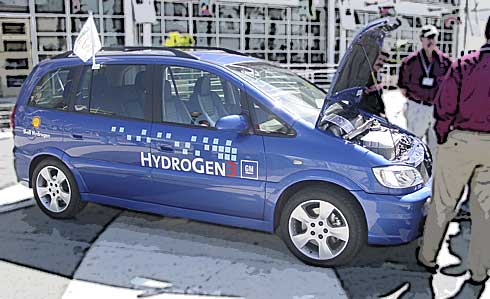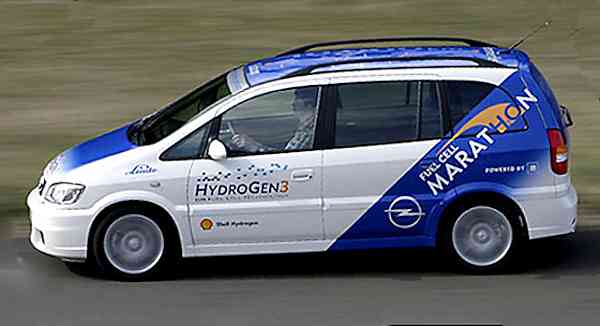GM HydroGen
The GM Hydrogen4 minivan is the next generation fuel cell vehicle from General Motors that one-ups the Hydrogen3 minivan. The GM Hydrogen4 was rolled out in Germany as part of the company’s Project Driveway program.
 GM HydroGen 3 Minivan |
The GM Hydrogen4 uses a 440-cell fuel cell stack, 73 Kw electric motor and has three carbon fiber hydrogen tanks that help propel the vehicle to a range of around 200 miles. The GM Hydrogen4 has a top speed of around 100 mph. The GM Hydrogen4 is also based upon the Opel Zafira like the Hydrogen3 vehicle.
General Motor’s HydroGen3 vehicle is the last general fuel cell vehicle that marked yet another milestone for GM in regards to pursuing a lineup of greener vehicles. The GM HydroGen3 is an environmentally friendly fuel cell minivan that has been used by FedEx as a delivery vehicle for real world testing trials.
According to Raymond Grigg Chairman and CEO of the Japan division of General Motors, “To really prove that fuel cell vehicles are equal to or better than conventional, internal combustion vehicles, you need to operate them under tough, every-day conditions. Our fuel cell technology has advanced to the point where it’s important to involve a real heavy-duty commercial user in our research and development activities. We expect to learn a lot by having FedEx Express put our HydroGen3 to the test on their daily delivery runs on the streets of Tokyo. This is how you truly prove durability and dependability.”

The HydroGen3 is designed based on the Opel Zafira MPV. Packed with more power then HydroGen1, and the latest of the HydroGen series, GM HygroGen3 has a simpler start up procedure and a more compact fuel cell stack. Not exactly a racecar (though it did participate in the Monte Carlo Rally), the HydroGen 3 accelerates from 0 – 60 mph in approximately 16 seconds. It has a top speed of 100 mph, which is respectable enough. The GM HydroGen 3 is powered by a 60 kW / 82 PS three-phase asynchronous motor. GM is testing both liquid hydrogen and compressed hydrogen storage systems with the HydroGen3.
The GM Hydrogen 3 has the same 5-seating capacity as the Opel Zafira and has participated in various demonstration projects around the world including Berlin, Germany. Two of the breakthroughs for the HydroGen3 has been the elimination of a buffer battery found in early versions to deal with peak electrical usage and a method for humidifying the fuel cell stack.
Here are some facts about the HydroGen3:
- Five seat, front wheel drive
- Fuel cell propulsion system packed as a single unit
The fuel cell propulsion system has:
- 200 individual fuel cells wired in a series
- Self humidifying stack
- Continuous output : 94 kilowatts
The liquid hydrogen storage system of the GM HydroGen3 is equipped with:
- vacuum insulated stainless steel tank
- capacity: 4.6 kilograms of liquefied hydrogen (temperatures of minus 253 degrees C )
- driving range : 250 miles
Compressed 700 hydrogen tanks have the following features:
- Two carbon composite tanks
- Service pressure: 10,000 psi
- Capacity: 3.1 kilograms of compressed hydrogen
- Driving range: 270km (170 miles)
The GM HydrogeGen3 was the first hydrogen fuel cell vehicle certified by the Japanese government for operation on regular roads. Another joint venture GM has for the GM HydroGen3 is with Shell. It’s two year program is being conducted in Washington DC giving the Members of Congress the chance to test drive the fuel cell vehicles. The US Postal Service also is using the GM HygroGen3 mini-van to deliver mail in and around the Washington DC area.
Leave a Reply
You must be logged in to post a comment.